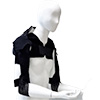| Oct 29, 2025 |
Automated weaving of shape-memory alloy fabric muscles enables scalable, lightweight wearable robots that assist multiple joints, moving closer to everyday use.
|
|
(Nanowerk News) The commercialization of clothing-type wearable robots has taken a significant step forward with the development of equipment that can continuously and automatically weave ultra-thin shape memory alloy coil yarn—thinner than a human hair—into lightweight and flexible “fabric muscle” suitable for large-scale production.
|
|
The Advanced Robotics Research Center at the Korea Institute of Machinery and Materials (KIMM), led by Principal Researcher Cheol Hoon Park, has developed an automated weaving system that enables the continuous mass production of fabric muscle, a lightweight yet powerful artificial muscle actuator (IEEE Transactions on Neural Systems and Rehabilitation Engineering, “Soft Exosuit Based on Fabric Muscle to Assist Shoulder Joint Movements in Patients With Neuromuscular Diseases”).
|
|
The newly developed system uses shape memory alloy (SMA) wire with a diameter of 25 μm—about one-fourth the thickness of a human hair—processed into coil-shaped yarn, enabling the continuous weaving of fabric muscles. This fabric, weighing only 10 g, can lift 10–15 kg, making it an ideal core actuator for clothing-type wearable robots.
|
 |
| Conceptual design of the proposed soft and simple shoulder joint assistive exosuit, featuring a fabric muscle woven with SMA spring thread. (Image: Reprinted from DOI:10.1109/TNSRE.2025.3613709, CC BY)
|
|
The SMA coil yarn previously developed by KIMM used a metallic core wire, which resulted in low elongation and made automatic weaving difficult. To overcome this limitation, the KIMM research team replaced the metal core with natural fiber, redesigned the structure and fabrication process of the fabric muscle, and improved the weaving machine’s design, thereby achieving stable and continuous mass production.
|
|
Conventional wearable robots designed to assist multiple joints—such as the elbow, shoulder, and waist—relied on heavy, noisy motor or pneumatic actuators, making them bulky, expensive, and uncomfortable for long-term use. As a result, most could provide only limited support to specific joints.
|
|
Active assistance for the shoulder has been particularly challenging due to its complex range of motion. In contrast, KIMM’s fabric muscle actuators are lightweight and flexible, allowing them to naturally conform to and actively assist multiple complex joints simultaneously.
|
|
Using this technology, the research team developed the world’s first clothing-type wearable robot, weighing less than 2 kg, that simultaneously assists the elbow, shoulder, and waist, reducing muscle effort by more than 40% during repetitive physical tasks.
|
|
Furthermore, the team created an ultra-lightweight shoulder-assist robot weighing just 840 g, which patients with muscle weakness can comfortably wear and carry in daily life. In clinical trials conducted at Seoul National University Hospital (SNUH) on patients with muscular weakness, including those with Duchenne muscular dystrophy, the wearable shoulder-assist robot improved shoulder movement range by more than 57%.
|
|
With the ability to continuously produce high-quality, uniform fabric muscle through the automated weaving system, the research team has laid the foundation for the commercialization of clothing-type wearable robots.
|
|
This breakthrough is expected to reduce workers’ physical strain, improve patients’ quality of life, and accelerate the widespread adoption of wearable robots, thereby enhancing industrial competitiveness. In particular, the shoulder-assist robot, designed to support rehabilitation and daily activities of patients with muscle weakness, is expected to reduce caregiver burden while improving patient independence, quality of life, and self-esteem, and overall well-being.
|
|
“Our development of continuous mass-production technology for fabric muscle—the key component of clothing-type wearable robots—will significantly improve quality of life in fields such as healthcare, logistics, and construction,” said Dr. Cheol Hoon Park, Principal Researcher at KIMM’s Advanced Robotics Research Center. “We will continue to build on KIMM’s extensive wearable robotics technologies to accelerate commercialization and lead the global wearable robotics market.”
|


